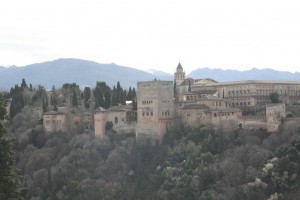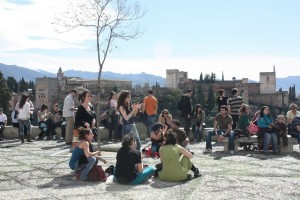Things to do in Granada
 Tucked at the foothills of the majestic Sierra Nevada mountain range is the charming Andalusian city of Granada. What used to be a stronghold of the Moorish empire is now a beautiful, culturally-rich city poised on steep slopes. Andalusian culture, warm, compassionate people and magnificent historical monuments are all part of the reason why Granada wins the hearts of many.
Tucked at the foothills of the majestic Sierra Nevada mountain range is the charming Andalusian city of Granada. What used to be a stronghold of the Moorish empire is now a beautiful, culturally-rich city poised on steep slopes. Andalusian culture, warm, compassionate people and magnificent historical monuments are all part of the reason why Granada wins the hearts of many.
Just an hour north of the Mediterranean Sea, the city of Granada also welcomes visitors with warm temperatures, delectable tapas and delicious gazpacho. Besides the spectacular setting, the myriad of monuments and cultural landmarks are in abundance; here are some of the essential sights of Granada.
The Alhambra
Coming close to winning the title as one of the 7 Wonders of the World, the Alhambra is definitely one of the most architecturally-beautiful and well-preserved palaces in Europe. It is also said to be the most visited monument in Spain. Thanks to the country’s effort to conserve the monument, only a limited amount of visitors are allowed in the palace each day. Tickets are sold out months in advance and tourist s lining up to enter as early as 6am.
If you’re planning to visit, be sure to book your tickets online at least three months ahead to avoid disappointment. Entrance tickets come at a hefty price of 12euros each. There is, however, a part of the Alhambra that is free to enter; it even offers a panoramic view of the city beneath. (Read more about it here: ‘Free Things to do in Granada’.)
To see the Alhambra is to witness nature and art come together in astonishing perfection. The Moorish Palace offers a unique historical perspective with its culturally and artistically intricate designs. Entering the sprawling gardens of Generalife, you are transported into the lives of ancient Arabic kings and queens. Restored patios, courtyards and fountains give you a glimpse of how they once ruled. The Alhambra also offers some of the best views of the city. Atop the tallest tower (you can climb to its rooftop), the white-washed city unfurls upon you.
>>Read more Visiting the Alhambra in Granada
 The Cathedral and Capilla Real
The Cathedral and Capilla Real
Granada’s historic center is concentrated around the city’s Cathedral. Like most cathedrals in Spain, this one spots a gothic exterior with sky soaring ceilings and giant organs inside the building. The Granada Cathedral might not be as grand and majestic as the one in Seville, but it makes up with a stunning interior. Be sure to check out the Cathedral from its Bib Rambla entrance, where intricate carvings of saints stand above the giant gates.
Beside the Granada Cathedral, you’ll find a small chapel in the same edifice. La Capilla Real is the tomb of the Catholic Monarchs, Fernando and Isabel, who reclaimed Granada from Moorish forces and helped to fund Christopher Columbus’s voyage in 1942. When you enter the chapel, you’ll see a passageway that goes underground. There, you’ll get face to face with the Monarchs’ sarcophagus.
 Albayzín Barrio
Albayzín Barrio
The old part of Granada is built atop steep slopes, with narrow cobblestoned alleys weaving past two-storey white houses. Albayzín, easily the most beautiful part of town, is studded with gypsy caves and hilltop carmenes (houses with gorgeous, grand gardens).
Red and pink hibiscus flowers spill out of the tiny patios, onto tiny pathways where Spanish guitar players and hippy street performers linger. Most hotels in Granada are located here; some of them are housed in typical Andalusian-style houses. You can easily spend an entire day wandering through its streets and getting mesmerized by its setting.
During sunset, visitors and locals follow the meandering passways, through the cerca-XIV-century Moorish architecture, up to the Mirador de San Nicholas, to socialize and take in an awe-inspiring view of the Alhambra. The mirador, or viewpoint, is one of the most attractive spots in the city, backdropped by the famous Alhambra and the imposing snow-peaked Sierra Nevada in the distance.
Arabic-Style Bazaar: Alcaicería
What used to be an ancient Silk market is now a bustling bazaar called the Alcaicería. The labyrinth of shops is packed with exotic lamps, colourful fabric and leather, exuding Arabic influence in the air. Its spirited residents are friendly and always full of stories to tell. It’s easy to browse through the collection of handicrafts and potteries and end up with a bundle of souvenirs home.
Prices are surprisingly reasonable here, since one would easily expect to find tourist traps here. Don’t forget to haggle, it’s simply a way of doing business for the Arabic vendors.
Flamenco in the Sacromonte Caves
Poised on the hills of Sacromonte, this area is home to the city’s gypsy community (and hippies). A string of naturally-formed caves sit in this area, many of them have converted into flamenco tablaos to attract tourists. Still, most of the flamenco dancers and Spanish guitar players here are the real stuff.
Angst-filled dancers – dressed in long, polka dotted dresses – stamp their feet along to the dramatic guitar music, their melancholic voices echoing late into the night. These performances usually take place in small caves ornamented with porcelain plates and paintings of bullfights. Most of these flamenco shows cost around 15 to 20 euros per person. The show usually lasts for 2 hours, some tablaos include beers while others don’t.
For those who find these shows too costly, you might like to check out el Camborio. Unlike most other flamenco caves, this venue is a standard modern amphitheatre. But don’t let that boring interior fool you. When a veteran flamenco dancer takes the stage, the lights are dimmed and the curtain behind her opens up to a mind-blowing view of the Alhambra by night. Entrance tickets usually cost around 5 euros, depending on the type of performance.
Planning a trip to Granada? Read our Granada travel guide and find out more about Granada hostels.